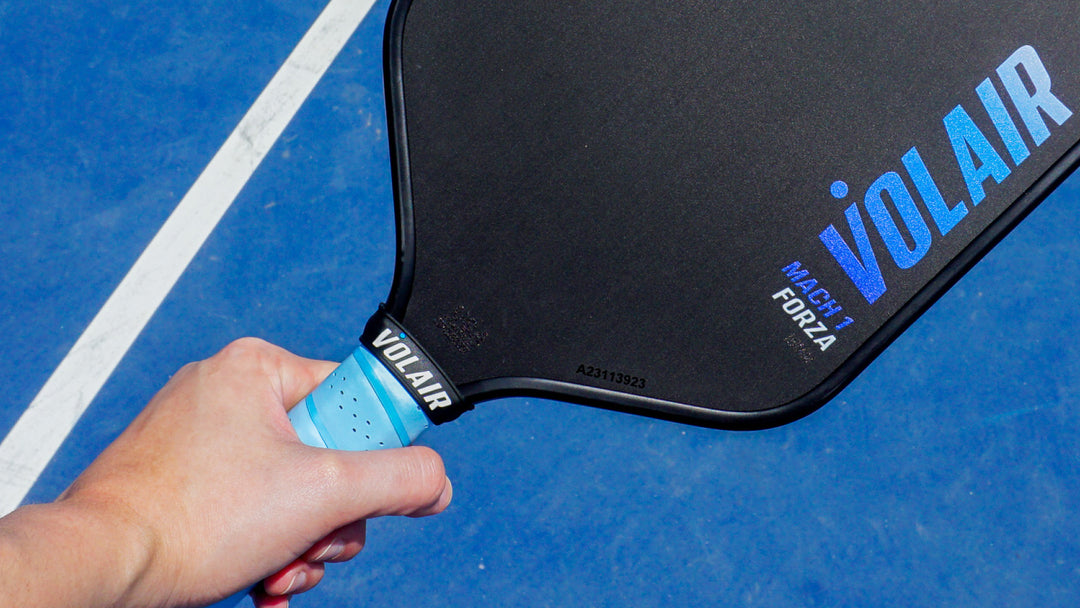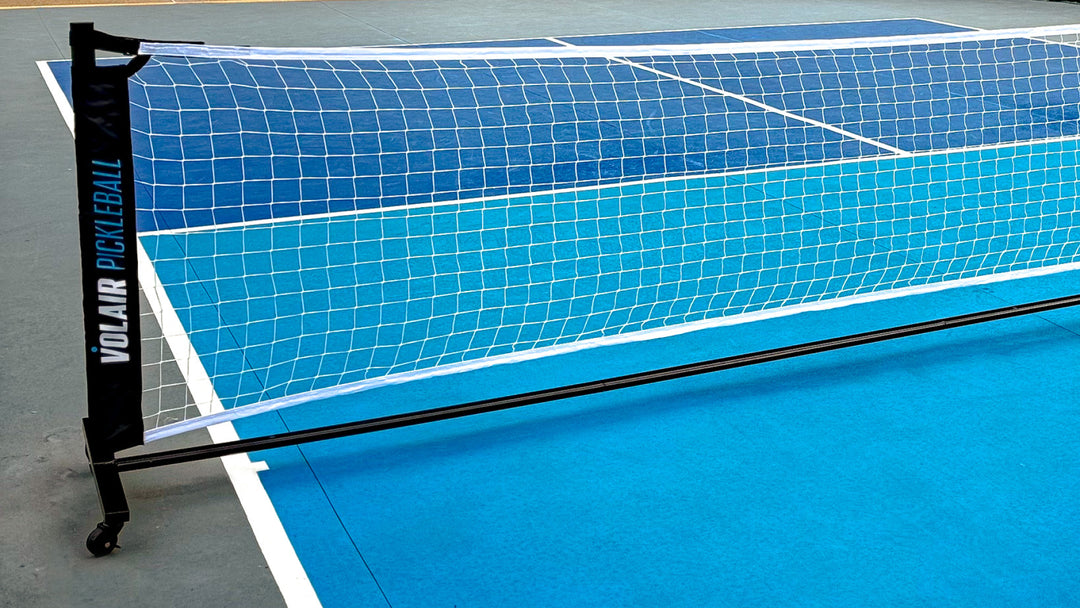Twist Weight?! Understanding Pickleball Paddle Stats
So you’re looking for a new pickleball paddle… how hard could that be? You surf to your favorite online store and click on a paddle that looks neat. Immediately, you’re greeted with a list of weights and measurements followed by material names like polypropylene honeycomb. Nodding to yourself, you remember that you like honey. And hey! T700 Carbon fiber? That’s a good fiber, right?
Undecided, you turn to reviewers for assistance. They start talking about RPMs, twist weights, swing weights, balance points, and the difference between pop and power. Pop is what happens when the ball hits your paddle; power is what happens when your paddle hits the ball… confused? Don’t worry! We’ve put together a comprehensive guide to pickleball paddle stats -- no physics degree required!
Physical Statistics
Let’s begin with the most basic characteristics of a paddle, its shape, size, and the materials from which it’s made.
Size
-
Length
- The length of a pickleball paddle is measured from the butt cap to the tip of its edge guard. If you stand the paddle on its butt, you can think of the length as its height. According to the USA Pickleball, the max length of a paddle is 17”.

-
Width
- The width of the paddle is measured at the widest part of the paddle from side to side. There’s no restriction on width, but the width and length combined cannot exceed 24” according to regulations.

Shape
More surface makes it easier to hit the ball, but it also makes it harder and slower to push against the air as you swing. Still, the flexibility afforded by the rules in length and width have resulted in many different shapes. Here’s a few you might come across:
- Elongated: These paddles favor length over width, usually they are 16.5” or longer. The advantage is greater reach and more potential power, as the tip of the paddle moves faster than the grip. The Volair Mach 1 Forza is a great example of this shape.
- Standard: The typical paddle is around 16” long and around 8” wide. Being between Elongated and Widebody paddles makes these well-rounded options, balancing power and control.
- Teardrop: These paddles feature a longer taper near the grip and a rounded head. This shape pushes the balance point further up the length of the paddle and extends the sweet spot closer to the tip. Volair paddles all feature a bit of rounding at the head.
- Widebody: These paddles give up length for width, usually they are under 16″ in length. They’ve got great control, boasting an enhanced “sweet spot,” discussed later. Check out the Volair Mach 2 Forza for an example.
- Hybrid: You may hear of a “hybrid” paddle shape. This can be confusing because there are also hybrid faces and manufacturing processes, but typically it describes paddles that measure between elongated and standard, you can say 16.25”, sometimes slightly widening towards the head and ending in a rounded top, like the Volair Mach 1 Pickleball paddle.
Thickness
We’ve discussed two-dimensions, but we live in a 3D world, so let’s talk about thickness! Although there are no restrictions on a paddle’s thickness, they typically come in either 14mm or 16mm.
- 14mm paddles are lighter and offer more pop.
- 16mm paddles are slightly heavier, but tend to offer more control.
- Most manufacturers, like Volair, offer 14mm and 16mm options for most models.

Grip
- Most handles are between 5-5.5” in length. If you favor two-handed backhands, you’ll want a longer grip.
- The grip circumference, sometimes called width, is fairly standardized between 4.125-4.25”. It’s all about comfort, so this will vary from person to person.
Weight (Static Weight)
- The “static” weight listed in the product description might not tell the whole story; weight distribution, balance, and aerodynamics have a lot to do with how heavy a paddle feels.
- Weight can impart power and control, but most manufacturers strive to keep their paddles light, averaging between 7.8-8.2oz.
Balance Point
- Imagine balancing a paddle on top of a net with the grip on one side and the head on the other. The balance point describes how much of the paddle would have to be on the grip side to maintain balance. Higher numbers typically mean that the paddle will feel more top heavy. This might let you drive through the ball better, but comes at the cost of hand speed and maneuverability.

Materials
-
Core
- Cores are commonly made of polypropylene honeycomb, which is a hexagonal mesh of plastic. It provides an optimal balance between durability, shock-resistance, vibration dampening, and rebound capability while remaining relatively light.
-
Face
- You may come across materials like kevlar and fiberglass, but T700 carbon fiber is the standard. It’s stronger and stiffer than steel, yet lighter.
- “Toray” carbon fiber is just a premium brand name.
- “Raw” carbon fiber doesn’t imply that other paddles are cooking their carbon! It just means it’s pure, not blended with other materials.
-
Surface Hardness
- Most modern paddles have a surface hardness between 82-95 Shore D, which is a measurement of how hard it is to put a divot into the material. The scale only goes to 100, so this is quite stiff!
- Carbon Fiber is very stiff, while kevlar and fiberglass are less stiff.
- These differences don’t affect the pop or power of the paddle as much as you might expect, but can give them a different sound and feel.
Functional Statistics
The physical characteristics of a paddle are a good place to start, but when people talk about how it plays, they use functional statistics.These stats are a measure of how fast, powerful, and stable the paddle will feel. They require more than a scale or ruler to derive, and the method used can skew them, so once you find a source for your stats like Johnkew’s very comprehensive spreadsheet or Pickleball Studio’s more exhaustive list of paddles, stick with it.
Swing Weight
- Swing weight is a measurement of how much force it takes to swing the paddle through the air. It’s a much more accurate representation of how fast the paddle will feel in your hands, having as much to do with balance point and aerodynamics than static weight.
- If fast and furious hand battles at the kitchen line are your game, this stat is vital!
- Lower swing weight means the paddle will feel faster as it requires less force to move it.
- However, more weight, particularly towards the head of the paddle, can add heft behind your swings and therefore power. It also typically leads to a more generous sweet spot.
- Swing weight can be determined with machines or math.
- Paddles typically range between 90-130, with the majority measuring around 110-120(kg*cm2). Any paddle around 100 is extremely fast, and one over 120 will feel sluggish.

Twist Weight
- Twist weight might be the most overlooked stat. It’s a measurement of how much force it takes to cause the paddle to rotate in your hand. Even if your paddle only slightly twists as it hits the ball, this declaration can throw off your shot, sending the ball limping into the net or bouncing off at an odd angle.
- Twist weight ranges between 4.3-8.3, with the majority of paddles falling between 6.0-6.7.
- This is likely the most important stat for determining a paddle’s sweet spot.
- Good control paddles have higher twist weights. Other stats remaining equal, there’s no negative to a higher twist weight.

Sweet Spot
- A sweet spot is not really a stat, but it’s a term you’ll undoubtedly encounter. Basically, it’s an area near the center of the paddle that provides the greatest amount of energy returned to the ball, and causes the least amount of vibration and twisting force.
- You’ve probably felt and heard the effects of a sweet spot. When you hit the sweet spot, you will hear a clean pop with little vibration. Off-center hits tend to sound tinny and transfer more shock to your hand, resulting in a loss of power.
- You may also hear it referred to as a paddle’s “forgiveness” because it improves the results of off-center hits.

Pop VS Power
When I described pop as what happens when the ball hits your paddle, and power as what happens when your paddle hits the ball, I wasn’t just being cheeky. That's exactly what it is! For clarity, let’s discuss how they’re measured.
-
Pop
- Reviewer, Johnkew Pickleball, lists pop in terms of hand volley speed.
- Imagine an opponent bangs the ball as hard as they can. You are standing at the kitchen line, holding your paddle firmly. The ball strikes your stationary paddle in the sweet spot, bouncing back at them. The speed at which the ball returns is the “pop” of the paddle.
- You can also imagine holding a paddle firmly on a surface and dropping a ball on its sweet spot. How high the ball bounces is another measurement of the pop. Whether the paddle weighs 8 oz or 8lb makes little difference in this test.
-
Power
- Johnkew lists power in terms of speed from a serve.
- In the case of a serve, the ball is not moving towards you, so you are not reflecting its energy, you are transferring your force to the ball.
- Now, if the paddle is moving at the same speed, weight makes a big difference, since Force = Mass * Acceleration.
- Weight near the head of the paddle will give it greater stability in that area, allowing you to strike further up the height of the paddle, which is moving faster during a swing, yielding greater power.
- Power is not determined by any single statistic. The question is: how much mass are you swinging, how fast, and how well is the energy transferred to the ball?
Spin
- Power might be good for hitting home runs in baseball, but spin is key to keeping the ball in the court. If you’re a power player, you’ll want a paddle with plenty of spin, like the Volair Mach 1 Forza.
- Spin is typically measured in rotations per minute (RPM). A tester may hit multiple serves with a marked ball and count the number of times the ball spins during a period of time using a high-speed camera.
- Much of a paddle’s spin is generated by the grit of its surface. Although the grittiness is restricted by USA Pickleball regulations, there’s no limit on the amount of RPMs a paddle can achieve.
- Apart from taming power, spin can put effects on the ball to throw your opponents off. For instance, a lot of backspin can send their return crashing into the net, as it adds unexpected top spin to their shot. This makes spin great for control players as well.
Type
Finally, we come to paddle types, which are pretty simple to understand since they only range across a single spectrum. On one end, you have power paddles and on the other you have control paddles. The ones that fall in the middle are referred to as “all-court.”
- Power paddles obviously score high on power, but they can have a good amount of pop as well. Because of this, they can be heavy or light. Spin is practically a must, and they’ll commonly favor 14mm and an elongated shape.
- Control paddles will have a higher twist weight and are more concerned with consistency. Spin doesn’t hurt, and while lightness is greater hand speed, a bit of weight is important for consistency and feel. Generally, they’re more likely to be widebody and 16mm thick.
In summary, exploring the world of pickleball paddle stats may initially seem like deciphering a complex equation, but armed with the right knowledge, anyone can find the perfect paddle to suit their game. From understanding the physical characteristics like size, shape, and thickness to delving into functional statistics such as swing weight and twist weight, each aspect contributes to the overall performance on the court. While the terminology may be daunting at first, our comprehensive guide aims to demystify these stats, ensuring that players can make informed decisions without the need for a physics degree. Whether you're seeking power, control, or a balance of both, the key lies in finding the paddle that aligns with your playing style and preferences. So, next time you're faced with the myriad options online, approach your pickleball paddle purchase with confidence, knowing that you have the knowledge to make a well-informed choice. After all, in the dynamic world of pickleball, the right paddle can make all the difference between a good game and a great one.




